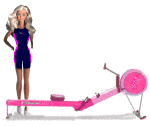 |
HEART RATE TRAINING
A guide to training zones and working out your maximum |
|
LESS PAIN, MORE GAIN?
There are a lot of people who still believe that all ergos should be done by pulling as hard as you possibly can, from start to finish. And, if you don't fall off vomiting at the end, having beaten your personal best - you haven't trained properly. However, most coaches are now taking a more scientific approach to training and it's fairly common practice to find the level of intensity specified in your training programme. This is normally done by stating the percentage of your maximum Heart rate that the training session should be done at. The following is an attempt to explain the benefits of the different heart rate training zones and some of the terms you may come across. WHAT'S MY MAXIMUM HEART RATE?
You may have been told that you can roughly work out your max HR by taking your age away from 220. The problem is, that although this will give a reasonable approximation for people who DON'T exercise, Maximum HR declines at a lot slower rate in people who have been exercising regularly for years In reality, the only real way to find out your true maximum heart rate, is to have it tested properly but, in the meantime, the following will give you a rough idea. FOR FIT WOMEN (in beats per minute): MAX HR = 211 - (YOUR AGE/2)
RESTING HEART RATE

CALCULATING YOUR ZONES
Each training zone is a percentage of your Working Heart Rate, added to your Resting Heart Rate.
but don't worry - you don't have to do lots of sums - you can use the following calculator to work out upper and lower heart rate limits. It uses a simple formula to work out Max HR, so if you know your true max and it's different, I suggest you lie about your age so it fits.
HEART RATE TRAINING ZONES
The value of each training zone should not be underestimated and although it may feel strange the first time you do an ergo at 65% (because it doesn't hurt and you're not sweating like a pig), resist the temptation to pull harder and just keep at it, it's on your programme for a reason. The Energy Efficient or Recovery Zone - 60% to 70% Much of the benefits from heart rate training involve the body's energy systems and one of these systems is responsible for the long term supply of energy to your working muscles. The Aerobic Zone - 70% to 80% When you train in this Heart Rate zone, you are training your cardiovascular system. Within this range, the body's ability to transport oxygen to, and carbon dioxide away from, the working muscles can be developed and improved. The Anaerobic Zone - 80% to 90% This is the zone in which an enormous amount of benefit can be gained. The Red Line Zone 90% to 100% In this zone you will only be able to train for short periods of time. It effectively trains your fast twitch muscle fibres and helps to develop speed. AND FINALLY...
Ultimately, if you want to train using heart rate, you will need to buy a heart rate monitor. The watch can be easily attached to a blade handle or round the centre of the handle on an ergo, so you can see what's going on. Concept 2 also sell an attachement for their newer model ergs, which will pick up your HR (if you're wearing a HR belt) and display it in the drag box - just make sure your not erging near to someone else wearing a HRM, or you may wonder why your heart rate is 378 at quarter slide.... The main benefit of Heart Rate training is that you train to your own realistic levels. Break free of the curse of the 500m Av split, as heart rate tells you when slow down as well as when you should pull harder. Just set the erg to "calories" and keep an eye on the heart rate monitor instead. If you want to find out more, there are lots of internet sites about Heart rate training, some of which make more sense than others. Most of the (VO2) max tests you'll find are for runners but I do have details (somewhere) on how you can work out your maximum heart rate, with the help of an ergo, a heart rate monitor and a friend. I'll link to it when I find it. happy training... |
